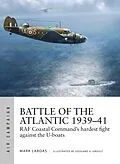This is the David-and-Goliath story of how RAF Coastal Command battled with outdated aircraft against the deadly U-boat fleet during the crucial first years of World War II.
At the start of World War II, few thought the U-boat would be as devastating as it proved to be. But convoys and sonar-equipped escorts proved inadequate to defend the Allies' merchantmen, and the RAF's only offensive weapon was the anti-submarine warfare (ASW) aircraft. For RAF Coastal Command, the first two years of the war were the hardest. Although starved of resources, operating with outdated aircraft and often useless weaponry, they were still the only force that could take the fight to the U-boats.
But in these two years, the RAF learned what it needed to win the Battle of the Atlantic. Gradually developing new tactics and technology, such as airborne radar, signals intelligence, and effective weaponry, the Allies ended 1941 in a position to defeat Dönitz's growing fleet of U-boats.
This book, the first of two volumes, explains the fascinating history of how the RAF kept the convoys alive against the odds, and developed the force that would prevail in the climactic battles of 1942 and 1943.
Autorentext
Mark Lardas has been fascinated by things related to the sea and sky his entire life. From building models of ships and aircraft as a teen, his maritime interest led him to study Naval Architecture and Marine Engineering, but his interest in aviation led him to take a job on the then-new Space Shuttle program. Over the next 30 years he worked as a navigation engineer on the Shuttle program. Currently he works on NASA's Lunar Gateway Project. He has written extensively about aircraft and warships and is the author of over 40 books, most related to military, naval or maritime history.
Klappentext
At the start of World War II, few thought the U-boat would be as devastating as it proved to be. But convoys and sonar-equipped escorts proved inadequate to defend the Allies' merchantmen, and the RAF's only offensive weapon was the anti-submarine warfare (ASW) aircraft. For RAF Coastal Command, the first two years of the war were the hardest. Although starved of resources, operating with outdated aircraft and often useless weaponry, they were still the only force that could take the fight to the U-boats.
But in these two years, the RAF learned what it needed to win the Battle of the Atlantic. Gradually developing new tactics and technology, such as airborne radar, signals intelligence, and effective weaponry, the Allies ended 1941 in a position to defeat Dönitz's growing fleet of U-boats. This book, the first of two volumes, explains the fascinating history of how the RAF kept the convoys alive against the odds, and developed the force that would prevail in the climactic battles of 1942 and 1943.
Inhalt
Introduction
Chronology
Attacker's Capabilities
Defender's Capabilities
Campaign Objectives
The Campaign
Aftermath and Analysis
Further Reading
Index
